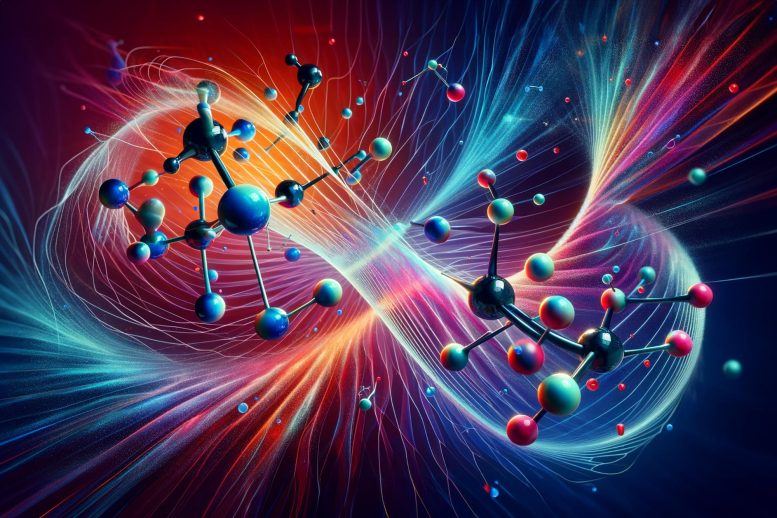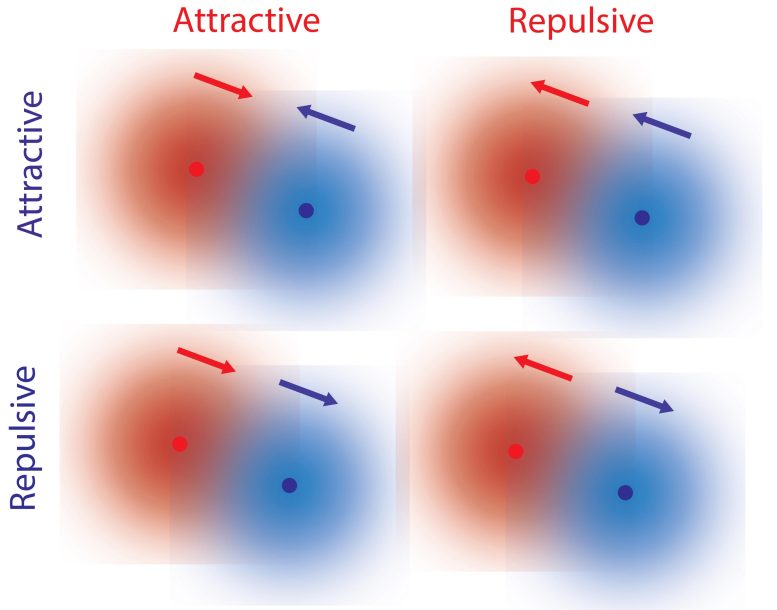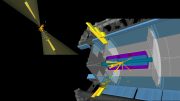
A team of researchers has uncovered a novel way that molecules can interact non-reciprocally without external forces, through a mechanism involving kinetic asymmetry. This discovery challenges traditional views on molecular interactions and could have profound implications for understanding life’s evolution and designing molecular machines. Credit: SciTechDaily.com
Scientists have found that molecules can interact in a non-reciprocal manner without external forces, a discovery that could change our understanding of molecular interactions and the evolution of life.
Researchers from the University of Maine and Penn State discovered that molecules experience non-reciprocal interactions without external forces.
Fundamental forces such as gravity and electromagnetism are reciprocal, where two objects are attracted to each other or are repelled by each other. In our everyday experience, however, interactions don’t seem to follow this reciprocal law. For example, a predator is attracted to prey, but the prey tends to flee from the predator. Such non-reciprocal interactions are essential for complex behavior associated with living organisms.
For microscopic systems such as bacteria, the mechanism of non-reciprocal interactions has been explained by hydrodynamic or other external forces, and it was previously thought that similar types of forces could explain interactions between single molecules.
In work published in the prestigious Cell Press journal Chem, UMaine theoretical physicist R. Dean Astumian and collaborators Ayusman Sen and Niladri Sekhar Mandal at Penn State have published a different mechanism by which single molecules can interact non-reciprocally without hydrodynamic effects.
This mechanism invokes the local gradients of reactants and products due to the reactions facilitated by every chemical catalyst, a biological example of which is an enzyme. Because the response of a catalyst to the gradient depends on the catalyst’s properties, it is possible to have a situation in which one molecule is repelled by, but attracts, another molecule.
Kinetic Asymmetry: A Key Factor
The authors’ “Eureka moment” occurred when, in their discussion, they realized that a property of every catalyst known as the kinetic asymmetry controls the direction of response to a concentration gradient. Because kinetic asymmetry is a property of the enzyme itself, it can undergo evolution and adaptation. The non-reciprocal interactions allowed by kinetic asymmetry also play a crucial role in allowing molecules to interact with each other, and may have played a critical role in the processes by which simple matter becomes complex.

A graphic illustrating the four possible interactions between two particles, where the arrows indicate the force experienced by the particle of that color due to the gradient surrounding the particle of the other color. The interactions shown in the upper left-hand and lower right-hand corners illustrate reciprocal interactions where the two particles attract each other, or where they repel each other, respectively. The upper right-hand graphic illustrates a situation where the red particle attracts the blue particle, but the blue particle repels the red particle. The lower left-hand graphic illustrates a situation where the red particle repels, but is attracted to, the blue particle. Graphic courtesy of R. Dean Astumian. Credit: R. Dean Astumian
Much previous work has been done by other researchers on what happens when non-reciprocal interactions occur. These efforts have played a central role in the development of a field known as “active matter.” In this earlier work, the non-reciprocal interactions were introduced by incorporation of ad hoc forces.
The research described by Mandal, Sen, and Astumian, however, describes a basic molecular mechanism by which such interactions can arise between single molecules. This research builds on earlier work in which the same authors showed how a single catalyst molecule could use energy from the reaction it catalyzed to undergo directional motion in a concentration gradient.
Impact on Biomolecular Machines and Early Life
The kinetic asymmetry that features in determining the non-reciprocal interactions between different catalysts has also been shown to be important for the directionality of biomolecular machines, and has been incorporated in the design of synthetic molecular motors and pumps.
The collaboration between Astumian, Sen, and Mandal aims to reveal the organizational principles behind loose associations of different catalysts that may have formed the earliest metabolic structures that eventually led to the evolution of life.
“We’re at the very beginning stages of this work, but I see understanding kinetic asymmetry as a possible opportunity for understanding how life evolved from simple molecules,” Astumian says. “Not only can it provide insight into complexification of matter, kinetic asymmetry can also be used in the design of molecular machines and associated technologies.”
Reference: “A molecular origin of non-reciprocal interactions between interacting active catalysts” by Niladri Sekhar Mandal, Ayusman Sen and R. Dean Astumian, 29 December 2023, Chem.
DOI: 10.1016/j.chempr.2023.11.017
Astumian joined UMaine’s Department of Physics and Astronomy in 2001. His research focuses on biophysics, condensed matter physics, and chemically driven molecular machines.
He was named a fellow of the American Association for the Advancement of Science (AAAS) In 2016. His other honors include the Galvani Prize of the Bio-electrochemical Society, the Humboldt Prize, the Feynman Prize, and the Royal Society of Chemistry Horizon Prize, the Perkin Prize in physical organic chemistry.









The medium seems critical here, presumably water, an asymmetric molecule with some fascinating geometrical influences. One can visualize streams of water molecules stacking and parting like chevrons all facing together, one orientation tending to be facing up to any eddy current, the opposite side facing against. In the case of a vacuum medium maybe this is supposed to be relevant to electron spin handedness. I’ve noticed a Harvard prof is arguing that space itself has a “handedness” orientation built into it. Haven’t thought about it much, it didn’t hit me well right off the bat, but who knows maybe it will grow on me before I look into the math. Still seems more likely I’ll develop my own individual take, at the moment.
Catalysis implies a surface with a medium covering it. The surface could have opposite effects on opposite sides of one reactant in comparison to the orientation of effects on the other reactant. Not just the surface but a combination of the covering medium and surface could assist in opposing-reactant tropes.
This finding illustrates the interaction that I have been imaging in my mind of how all forms from quantum up through to the interactions of planets to their host stars. I have recently read about the shape of our universe that fits a theory of being flat do to ever expansion and all data does fit except the singularity, I would ask is our universe the first only or could we be players in a multiple number of starts evolve then collapses and then singularity of beginning again. the singularity is the clue so much time that passes and all information dissolves of any order then slips (moves) sparking the expansion of a new intellect, what we know now will never be historically imprinted in the collapse other than after time an intelligents is inquisitive enough to form a theory of the singularity. My evidence shows the universe as a sphere and the equation of E=mc squared PI and the singularity is the God particle that many are looking for.
“My evidence shows the universe as a sphere and the equation of E=mc squared PI and the singularity is the God particle that many are looking for.”
But the cosmic website bridge maiden defender has many faces, speaks fluent nuclear hasbara, knows the first rule of particle smite club is to keep it in the holy closet!
“Researchers from the University of Maine and Penn State discovered that molecules experience non-reciprocal interactions ***without external forces.”***
My suggestion is to call them Godless particles, imo they are possibly over-reacting to locally homophobic fields, but that call is over ultimately my pay grade as I am but a channel until the great reset.